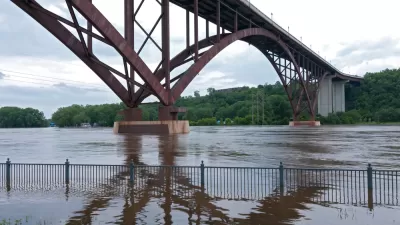While New York City's congestion pricing scheme waits for needed federal approval, political support seems to waver.

According to Dana Rubinstein, New York City officials still aren’t sure if a proposed congestion pricing scheme requires an environmental assessment or an environmental impact statement. The latter could take years to complete. The reason for the lack of certainty: officials at the U.S. Department of Transportation haven't communicated an answer to that question, despite officials at the city and state level posing the question to federal officials ten months ago.
"That haziness puts MTA officials, and the massive system-wide rehabilitation plan whose funding is reliant on congestion pricing, in a serious bind," writes Rubinstein.
The plan was to launch the congestion pricing scheme in January 2021, but that's looking less likely all the time—especially if the city and the state eventually do have to undertake an environmental impact statement.
In a later, follow up article on the same subject, Rubinstein reports that New York Governor Andrew Cuomo has begun to cast doubt on the program. 'I’m not holding my breath for them to approve congestion pricing,' Cuomo is quoted as saying in the article.
Paul Berger originally reported the federal delay on the congestion pricing scheme in a paywalled article for the Wall Street Journal.
FULL STORY: Why congestion pricing might be delayed

Study: Maui’s Plan to Convert Vacation Rentals to Long-Term Housing Could Cause Nearly $1 Billion Economic Loss
The plan would reduce visitor accommodation by 25,% resulting in 1,900 jobs lost.

North Texas Transit Leaders Tout Benefits of TOD for Growing Region
At a summit focused on transit-oriented development, policymakers discussed how North Texas’ expanded light rail system can serve as a tool for economic growth.

Why Should We Subsidize Public Transportation?
Many public transit agencies face financial stress due to rising costs, declining fare revenue, and declining subsidies. Transit advocates must provide a strong business case for increasing public transit funding.

How to Make US Trains Faster
Changes to boarding platforms and a switch to electric trains could improve U.S. passenger rail service without the added cost of high-speed rail.

Columbia’s Revitalized ‘Loop’ Is a Hub for Local Entrepreneurs
A focus on small businesses is helping a commercial corridor in Columbia, Missouri thrive.

Invasive Insect Threatens Minnesota’s Ash Forests
The Emerald Ash Borer is a rapidly spreading invasive pest threatening Minnesota’s ash trees, and homeowners are encouraged to plant diverse replacement species, avoid moving ash firewood, and monitor for signs of infestation.
Urban Design for Planners 1: Software Tools
This six-course series explores essential urban design concepts using open source software and equips planners with the tools they need to participate fully in the urban design process.
Planning for Universal Design
Learn the tools for implementing Universal Design in planning regulations.
Ascent Environmental
Borough of Carlisle
Institute for Housing and Urban Development Studies (IHS)
City of Grandview
Harvard GSD Executive Education
Toledo-Lucas County Plan Commissions
Salt Lake City
NYU Wagner Graduate School of Public Service





























